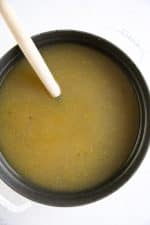

Chicken Stock Recipe - How to Make Chicken Stock
This homemade chicken stock recipe is incredibly easy to prepare using simple ingredients like leftover chicken bones (with or without meat), vegetable scraps, and fresh herbs.
Servings: 12 cups (approx.)
Calories: 295kcal
Ingredients
- 1 whole chicken - (approx. 4-5 pounds)
- 1 pound chicken feet or chicken necks - (optional)
- 2 medium yellow onions - quartered
- 3 large carrots - unpeeled and chopped into 2-inch pieces
- 3 ribs celery - chopped into 2-inch pieces
- 1 head garlic - unpeeled and cut in half crosswise
- 1 small bunch fresh parsley
- 2 sprigs fresh rosemary
- 3 bay leaves
- 8 sprigs fresh thyme
- 10 leaves fresh sage
- 1 tablespoon salt - plus more to taste
- 1 tablespoon black peppercorns
Instructions
- Roast the chicken and vegetables: Preheat oven to 450°F. Remove the neck and gizzards from the inside of your chicken and stuff with 4-5 pieces of chopped vegetables. Transfer your chicken to a large roasting pan, breast-side-up. Scatter the remaining vegetables and garlic around your chicken, trying not to overcrowd your pan (use two roasting pans or a baking sheet if necessary). Transfer to the oven and roast for 30 minutes before very carefully flipping your chicken over to roast the other side for an additional 15-30 minutes.
- Transfer the chicken and vegetables to a large stockpot: If your chicken is not cooked completely, that's ok. Transfer your chicken and vegetables to a large stockpot (ideally 12-16-quarts). Scrape out any bits that may be stuck to the roasting pan and transfer to your pot (flavor, remember). Add the fresh parsley, rosemary, bay leaves, thyme, sage, salt, and black peppercorns to your pot. Fill your pot with cold water so that your chicken and vegetables are completely submerged.
- Bring to a boil and simmer: Cover with a tight-fitting lid and place on the stovetop set over high heat. Bring to a gentle boil. Immediately reduce heat to low and simmer, with the lid slightly ajar, skimming any foam or excess fat, occasionally.
- Remove meat and return the carcass to the pot: After approximately one hour, remove your chicken from the pot (be very careful here!) and set aside to cool on a large rimmed baking sheet or jelly-roll pan. Once it is cool enough to touch, use your fingers to pick the meat from the bones, reserving the meat to use for soup, sandwiches, or salads, and the bones to toss back in the pot to continue boiling.
- Continue cooking: Allow your stock to boil for at least an additional 1-3 hours. Add more water if needed to make sure bones and vegetables remain fully submerged.
- Strain. Carefully strain your cooked stock through a cheesecloth (recommended) or fine mesh strainer and add a couple of handfuls of ice to expedite cooling and bring to room temperature (which is needed for storage).
- Skim the fat from your stock (optional): I do not recommend skimming all the fat from your stock. Fat is flavor, so leave a little. However, if you'd like to skim off part of the fat, transfer your pot to the refrigerator and allow it to cool fully. The result will be a hard layer of fat on the top. Use a fork or spoon to scoop off as much fat as you'd like.
- Storage: This chicken stock stores well in the refrigerator for approximately 5 days. Or, for larger batches, store leftovers in the freezer for up to 6 months.
Notes
Chicken: I chose to make this particular chicken stock recipe with one whole chicken, a few additional drumsticks, and about a pound of chicken necks. The chicken necks (or chicken feet) are completely optional but actually quite good for you. As for using a whole chicken rather than just the carcass? I did this on purpose for two reasons,
- I wanted the meat for soup (and quesadillas).
- I really wanted an extra rich, concentrated stock with loads of flavor.
- If you are using chicken bones or a chicken carcass, you may choose to skip this step altogether or just roast the vegetables- entirely up to you.
- Alternatively, if you are using chicken pieces (legs, wings, necks, bone-in skin-on thighs, you may also brown your chicken and veggies directly in your stockpot (as I did with this Instant Pot Bone Broth Recipe). It will take about the same time.
Nutrition
Calories: 295kcal | Carbohydrates: 4g | Protein: 25g | Fat: 19g | Saturated Fat: 5g | Cholesterol: 100mg | Sodium: 685mg | Potassium: 296mg | Fiber: 1g | Sugar: 1g | Vitamin A: 1168IU | Vitamin C: 11mg | Calcium: 71mg | Iron: 2mg
Did you make this recipe?Tag @theforkedspoon and hashtag it #theforkedspoon and please leave your star rating in the comment section on this post.
Copyright © 2024 The Forked Spoon